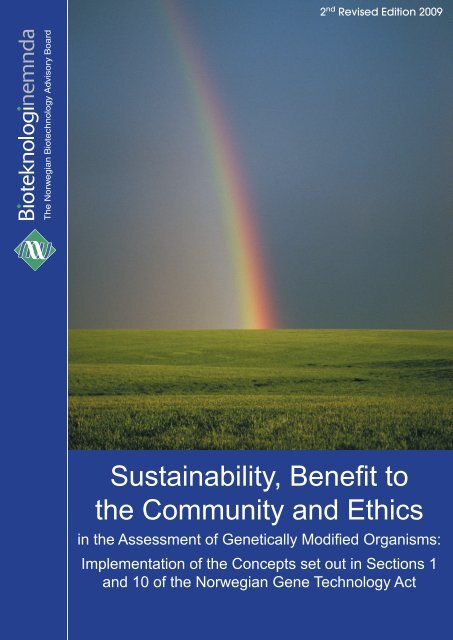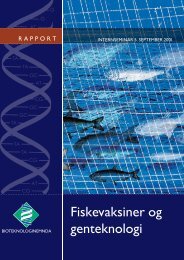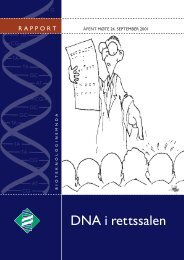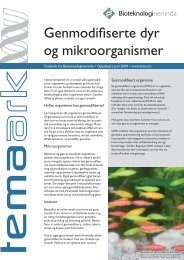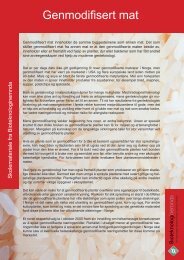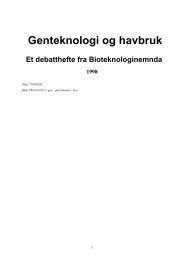Sustainability, Benefit to the Community and Ethics
Sustainability, Benefit to the Community and Ethics
Sustainability, Benefit to the Community and Ethics
- No tags were found...
You also want an ePaper? Increase the reach of your titles
YUMPU automatically turns print PDFs into web optimized ePapers that Google loves.
The Norwegian Biotechnology Advisory BoardContentsIntroduction 5Opinion of <strong>the</strong> Biotechnology Advisory Board 71. Decision-making structure 72. System limits 73. Danger of detrimental effects on health <strong>and</strong> <strong>the</strong> environment 84. Precautionary principle 105. Sustainable development 136. <strong>Benefit</strong> <strong>to</strong> <strong>the</strong> community 157. O<strong>the</strong>r ethical <strong>and</strong> social considerations 17
<strong>Sustainability</strong>, <strong>Benefit</strong> <strong>to</strong> <strong>the</strong> <strong>Community</strong> <strong>and</strong> <strong>Ethics</strong> in <strong>the</strong> Assessment of Genetically Modified OrganismsIntroductionThe Norwegian Act relating <strong>to</strong> <strong>the</strong>production <strong>and</strong> use of genetically modifiedorganisms 1strongly emphasizes that <strong>the</strong>deliberate release of such organisms shouldhave no detrimental effects on ei<strong>the</strong>r healthor <strong>the</strong> environment. This emphasis is fullyin line with <strong>the</strong> legislation of o<strong>the</strong>r nationsconcerning <strong>the</strong> regulation of geneticallymodified organisms (GMOs). In <strong>the</strong> Act’sprepara<strong>to</strong>ry work 2 , several references aremade <strong>to</strong> <strong>the</strong> concept of risk. One of <strong>the</strong>sereferences emphasizes that <strong>the</strong> wording“without detrimental effects on health <strong>and</strong><strong>the</strong> environment” in <strong>the</strong> purpose statemen<strong>to</strong>f <strong>the</strong> Act should not be interpretedThe Gene Technology Act,Section 10, excerpt:“The deliberate release of geneticallymodified organisms may only beapproved when <strong>the</strong>re is no risk of adverseeffects on health or <strong>the</strong> environment.In deciding whe<strong>the</strong>r or not <strong>to</strong> grant anapplication, considerable weight shallalso be given <strong>to</strong> whe<strong>the</strong>r <strong>the</strong> deliberaterelease will be of benefit <strong>to</strong> society<strong>and</strong> is likely <strong>to</strong> promote sustainabledevelopment.”Sustainable developmentThe World Commission definedsustainable development in <strong>the</strong> report“Our Common Future” (1987) as“development that meets <strong>the</strong> needs of<strong>the</strong> present without compromising <strong>the</strong>ability of future generations <strong>to</strong> meet<strong>the</strong>ir own needs”.The concept of “sustainable development”is included in <strong>the</strong> Gene Technology Actin two ways, both as part of <strong>the</strong> purposestatement of <strong>the</strong> Act <strong>and</strong> as an explicitcriteria for approval (Section 10, secondparagraph, see above).literally – but ra<strong>the</strong>r that <strong>the</strong> expression“without detrimental effects” has beenused <strong>to</strong> emphasize <strong>the</strong> aim of carrying outa prior assessment of <strong>the</strong> risk <strong>to</strong> health<strong>and</strong> <strong>the</strong> environment <strong>and</strong> avoiding possibledetrimental effects, <strong>and</strong> that this should beunderpinned by <strong>the</strong> precautionary principle.It is fur<strong>the</strong>r stated that “a strict assessmen<strong>to</strong>f risk <strong>to</strong> health <strong>and</strong> <strong>the</strong> environment is inline with <strong>the</strong> views of <strong>the</strong> Government <strong>and</strong><strong>the</strong> Parliament 3 ” (These concepts will bediscussed fur<strong>the</strong>r in Chapter 3).As distinct from <strong>the</strong> regulations of o<strong>the</strong>rnations, however, <strong>the</strong> Norwegian GeneTechnology Act also stresses that <strong>the</strong>deliberate release of such organisms shouldrepresent a “benefit <strong>to</strong> <strong>the</strong> community” <strong>and</strong>enable “sustainable development”. Theseconcepts are used in Sections 1 <strong>and</strong> 10 of <strong>the</strong>Norwegian Gene Technology Act.The EU has since established new GMOdirectives4 that move <strong>to</strong>wards <strong>the</strong> Norwegianlegislation. However, <strong>the</strong>re are still differencesin <strong>the</strong> emphasis on ethics <strong>and</strong> benefit <strong>to</strong> <strong>the</strong>community as <strong>the</strong> Norwegian laws dem<strong>and</strong>an assessment of <strong>the</strong> GMO’s contribution <strong>to</strong>sustainable development.However, it is not self-evident how“sustainability” <strong>and</strong> “benefit <strong>to</strong> <strong>the</strong>community” should be considered in termsof <strong>the</strong> practical application of <strong>the</strong> Act. In <strong>the</strong>light of <strong>the</strong> prepara<strong>to</strong>ry work, consultativestatements <strong>and</strong> <strong>the</strong> political debate on<strong>the</strong> Gene Technology Act, it is not clearwhe<strong>the</strong>r <strong>the</strong> provisions contained in Section10 relating <strong>to</strong> “benefit <strong>to</strong> <strong>the</strong> community”<strong>and</strong> “sustainable development” are <strong>to</strong> beconsidered as additional requirements oras a softening-up of <strong>the</strong> requirement for nodetrimental effects on ei<strong>the</strong>r health or <strong>the</strong>environment. “Sustainable development” <strong>and</strong>“benefit <strong>to</strong> <strong>the</strong> community” can be unders<strong>to</strong>odas ei<strong>the</strong>r:1. For <strong>the</strong> Gene Technology Act, see www.lovdata.no2. Ot. prp. nr.8 (1992-93)3. S<strong>to</strong>rtinget: The Norwegian Parliament4. Most importantly <strong>the</strong> deliberate release directive 2001/18/ECwhich in 2002 replaced directive 90/2205
<strong>Sustainability</strong>, <strong>Benefit</strong> <strong>to</strong> <strong>the</strong> <strong>Community</strong> <strong>and</strong> <strong>Ethics</strong> in <strong>the</strong> Assessment of Genetically Modified OrganismsOpinion of <strong>the</strong> Norwegian Biotechnology Advisory Board1. Decision-making structureIn <strong>the</strong> opinion of <strong>the</strong> Norwegian BiotechnologyAdvisory Board, Section 10 of <strong>the</strong> GeneTechnology Act should be interpreted <strong>to</strong>mean that <strong>the</strong> requirements of “sustainabledevelopment”, “benefit <strong>to</strong> <strong>the</strong> community”<strong>and</strong> o<strong>the</strong>r “ethical <strong>and</strong> social considerations”represent prerequisites that alone couldcarry decisive weight against granting anapplication, but that should also be consideredin relation <strong>to</strong>, <strong>and</strong> weighed against <strong>the</strong> risk ofdetrimental effects, when such risk is low.Hence, an assessment of <strong>the</strong> individualapplication will have <strong>the</strong> following structure:1) Danger of detrimental effects on health<strong>and</strong> <strong>the</strong> environment:a) what are <strong>the</strong> possible negativeconsequences?b) what is <strong>the</strong> likelihood of suchconsequences occurring?2) The precautionary principle:a) is <strong>the</strong> risk assessment associatedwith justified uncertainty?b) is <strong>the</strong>re a possibility of substantialor irreversible harm?3) Is it:a) in compliance with <strong>the</strong> principle of“sustainable development”?b) of “benefit <strong>to</strong> <strong>the</strong> community”?c) “ethically <strong>and</strong> socially justifiable”?If <strong>the</strong>re is a demonstrable yet minor risk ofdetrimental effects under item 1) <strong>and</strong> <strong>the</strong>precautionary principle is not applicableaccording <strong>to</strong> item 2), <strong>the</strong>n <strong>the</strong> contribution<strong>to</strong> “sustainable development” <strong>and</strong> “benefit <strong>to</strong><strong>the</strong> community” may be seen as significantenough <strong>to</strong> warrant that <strong>the</strong> applicationnever<strong>the</strong>less may be recommended (<strong>the</strong>application is in o<strong>the</strong>r respects ethically <strong>and</strong>socially defendable).The Biotechnology Advisory Board is anadvisory body <strong>and</strong> should in all cases consider“sustainable development”, “benefit <strong>to</strong> <strong>the</strong>community” <strong>and</strong> o<strong>the</strong>r “ethical <strong>and</strong> socialconsiderations”, even though it believes <strong>the</strong>remay be a serious risk of detrimental effectsinvolved. In <strong>the</strong> event that <strong>the</strong> opinions of <strong>the</strong>decision-making authority, <strong>the</strong> Ministry of<strong>the</strong> Environment, were <strong>to</strong> differ from that of<strong>the</strong> Biotechnology Advisory Board on <strong>the</strong> riskof <strong>the</strong> detrimental effects of an application,it is important that assessments of <strong>the</strong> o<strong>the</strong>rcriteria stipulated in <strong>the</strong> Act should be made.2. System limitsAn essential question is <strong>to</strong> underst<strong>and</strong><strong>the</strong> limits of <strong>the</strong> system relating <strong>to</strong> <strong>the</strong>cases for consideration. It is particularlyimportant not <strong>to</strong> define <strong>the</strong> system limits for“sustainable development”, “benefit <strong>to</strong> <strong>the</strong>community” <strong>and</strong> o<strong>the</strong>r “ethical <strong>and</strong> socialconsiderations” <strong>to</strong>o narrowly. The GeneTechnology Act uses <strong>the</strong> terms “production”<strong>and</strong> “use” <strong>to</strong> express this broader approach.This means that assessments should no<strong>to</strong>nly apply <strong>to</strong> <strong>the</strong> genetically modifiedproduct itself, but also <strong>to</strong> <strong>the</strong> productionsystem in a broader sense, which includes<strong>the</strong> production line – from development <strong>and</strong>pilot production <strong>to</strong> processing in a productionfacility – <strong>and</strong> <strong>the</strong>reafter <strong>the</strong> marketing, sales<strong>and</strong> distribution of <strong>the</strong> finished product. Butit also covers <strong>the</strong> properties of <strong>the</strong> productitself. The Biotechnology Advisory Boardfeels, <strong>the</strong>refore, that it might be useful <strong>to</strong>distinguish between three different conceptsthat jointly determine system limits:- product characteristics- production- useThis distinction applies primarily <strong>to</strong> <strong>the</strong>assessments of “sustainable development”,“benefit <strong>to</strong> <strong>the</strong> community” <strong>and</strong> “o<strong>the</strong>r ethical<strong>and</strong> social considerations”.7
The Norwegian Biotechnology Advisory Board3. Danger of detrimentaleffects on health <strong>and</strong> <strong>the</strong>environmentSection 10, second paragraph, of <strong>the</strong>Gene Technology Act uses <strong>the</strong> wording“danger of detrimental effects on healthor <strong>the</strong> environment”. The term “risk” isnot directly used in Section 1 of <strong>the</strong> Act(purpose statement) nor in Section 10,second paragraph. However, Section 10, fifthparagraph, contains <strong>the</strong> following wording:“The authorities responsible under <strong>the</strong> presentAct, however, may still prohibit or limit suchplacing on <strong>the</strong> market if in <strong>the</strong>ir opinion itinvolves a risk <strong>to</strong> health or <strong>the</strong> environmen<strong>to</strong>r if <strong>the</strong> placing on <strong>the</strong> market is o<strong>the</strong>rwisein conflict with <strong>the</strong> purpose of this Act”.Section 11 of <strong>the</strong> Act also uses <strong>the</strong> term “risk”:“Applications for approval of deliberate releasepursuant <strong>to</strong> section 10 shall contain an impactassessment setting out <strong>the</strong> risk of detrimentaleffects on health <strong>and</strong> <strong>the</strong> environment <strong>and</strong>o<strong>the</strong>r consequences of <strong>the</strong> release”.In <strong>the</strong> Act’s prepara<strong>to</strong>ry work, severalreferences are made <strong>to</strong> <strong>the</strong> concept ofrisk. It is, for instance, emphasized that<strong>the</strong> wording “without detrimental effectson health <strong>and</strong> <strong>the</strong> environment” in <strong>the</strong>purpose statement of <strong>the</strong> Act should not beinterpreted literally – but ra<strong>the</strong>r that <strong>the</strong>expression “without detrimental effects” hasbeen used <strong>to</strong> emphasize <strong>the</strong> aim of carryingout a prior assessment of <strong>the</strong> risk <strong>to</strong> health<strong>and</strong> <strong>the</strong> environment <strong>and</strong> avoiding possibledetrimental effects, <strong>and</strong> that this should beunderpinned by <strong>the</strong> precautionary principle 7 .It is fur<strong>the</strong>r stated that “a strict assessmen<strong>to</strong>f risk <strong>to</strong> health <strong>and</strong> <strong>the</strong> environment is inline with <strong>the</strong> views of <strong>the</strong> Government <strong>and</strong> <strong>the</strong>S<strong>to</strong>rting 3 ”.AssessmentWhen evaluating cases pursuant <strong>to</strong> <strong>the</strong>provisions of <strong>the</strong> Gene Technology Act, <strong>the</strong>Biotechnology Advisory Board <strong>the</strong>reforeconsiders <strong>the</strong> two concepts of “danger” <strong>and</strong>“risk” <strong>to</strong> be synonymous. When it is statedin Section 10, second paragraph, that adeliberate release of genetically modifiedorganisms may only be approved when <strong>the</strong>re7. Ot. prp. nr. 8 (1992-93) p 67is no danger of detrimental effects on healthor <strong>the</strong> environment, this must be unders<strong>to</strong>odas a declaration of intent <strong>to</strong> apply <strong>the</strong>provisions of <strong>the</strong> Act in a restrictive manner.In consequence, <strong>the</strong> deliberate release ofgenetically modified organisms may only beapproved when <strong>the</strong> risk of detrimental effectson health <strong>and</strong> <strong>the</strong> environment is low.Risk is per se a complex concept. TheBiotechnology Advisory Board applies <strong>the</strong>commonly accepted scientific <strong>and</strong> technicalunderst<strong>and</strong>ing of <strong>the</strong> term as a function oftwo fac<strong>to</strong>rs – consequence <strong>and</strong> probability –recognizing, never<strong>the</strong>less, that <strong>the</strong> produc<strong>to</strong>f <strong>the</strong>se two fac<strong>to</strong>rs does not provide anadequate underst<strong>and</strong>ing of risk in a decisionmakingcontext. In such a context, <strong>the</strong> riskinvolved may in fact be minor, even though<strong>the</strong> negative consequences may be verysubstantial. Hence, <strong>the</strong> Board concludesthat approving a deliberate release in suchan instance would be incompatible with<strong>the</strong> intentions of <strong>the</strong> Act, even when <strong>the</strong>reis a reasonably secure basis for probabilityassessments.It might be useful <strong>to</strong> introduce <strong>the</strong> concep<strong>to</strong>f “perceived risk”, i.e. <strong>the</strong> manner in whichrisk is perceived by individuals or societyas a whole. Perceived risk is, moreover,a commonly applied concept in recentdevelopments in <strong>the</strong> field of risk research– even in narrower scientific <strong>and</strong> technicalcontexts. Something that has seriousnegative consequences generally entailsgreater perceived risk, even if <strong>the</strong> probabilityof such consequences occurring is low. If so,it would not be acceptable <strong>to</strong> implement <strong>the</strong>measure or <strong>the</strong> deliberate release. This callsfor an additional prerequisite linked <strong>to</strong> <strong>the</strong>requirement of low risk, namely that <strong>the</strong>deliberate release of genetically modifiedorganisms may only be approved when <strong>the</strong>possible detrimental effects on health <strong>and</strong> <strong>the</strong>environment are minor.In general, every application for a deliberaterelease should be assessed in <strong>the</strong> light of <strong>the</strong>risk with which <strong>the</strong> specific release applied formay be associated, i.e. on a case-by-case basis.However, a number of serious consequencesmay arise as <strong>the</strong> cumulative effects of severalreleases, even if <strong>the</strong> effects of <strong>the</strong> individualreleases are minor. The term “cumulativeeffects” is relevant in such contexts. It8
<strong>Sustainability</strong>, <strong>Benefit</strong> <strong>to</strong> <strong>the</strong> <strong>Community</strong> <strong>and</strong> <strong>Ethics</strong> in <strong>the</strong> Assessment of Genetically Modified Organismsunderlines <strong>the</strong> need for a fur<strong>the</strong>r additionalprerequisite: that <strong>the</strong> deliberate release ofgenetically modified organisms may only beapproved when <strong>the</strong> cumulative detrimentaleffects on health <strong>and</strong> <strong>the</strong> environment ofseveral releases are minor.There is a connection between <strong>the</strong>seprerequisites for deliberate release <strong>and</strong> <strong>the</strong>application of <strong>the</strong> precautionary principle.The recommended prerequisites apply onlywhen <strong>the</strong> knowledge base is reasonably or<strong>to</strong>tally secure. This applies <strong>to</strong> knowledge of <strong>the</strong>consequences, as well as of <strong>the</strong> probabilities,including those related <strong>to</strong> cumulativeeffects. It also expresses ano<strong>the</strong>r additionalprerequisite – if <strong>the</strong>re is a reasonable degreeof doubt about <strong>the</strong> knowledge acquiredthrough impact assessments <strong>and</strong> <strong>the</strong> relatedrisk assessments, <strong>the</strong>n <strong>the</strong> precautionaryprinciple will (under certain conditions) apply.In this respect, we refer <strong>to</strong> <strong>the</strong> assessmen<strong>to</strong>f <strong>the</strong> conditions for <strong>the</strong> application of thisprinciple under <strong>the</strong> Gene Technology Act thatfollows below.CommentIf <strong>the</strong> answer <strong>to</strong> question 1 is “no”, <strong>the</strong> case willbe assessed in <strong>the</strong> light of <strong>the</strong> precautionaryprinciple. If <strong>the</strong> answer <strong>to</strong> one or more ofquestions 2 through 4 is “yes”, <strong>the</strong> applicationwill be rejected. If <strong>the</strong> answer <strong>to</strong> all questionsfrom 2 <strong>to</strong> 4 is “no”, <strong>the</strong> application will besubject <strong>to</strong> fur<strong>the</strong>r consideration in <strong>the</strong> light of<strong>the</strong> precautionary principle.Checklist questions1. Does <strong>the</strong> application provide adequatedocumentation for assessing possibledetrimental effects?2. Is it reasonable <strong>to</strong> assume that majoror significant risk <strong>to</strong> health or <strong>the</strong>environment is involved?3. Is it reasonable <strong>to</strong> assume that majoror significant negative consequencesfor health or <strong>the</strong> environment areinvolved?4. Is it reasonable <strong>to</strong> assume that majoror significant negative cumulativeconsequences for health or <strong>the</strong>environment are involved?9
The Norwegian Biotechnology Advisory Board4. Precautionary principleThe precautionary principle is not mentionedin <strong>the</strong> wording of <strong>the</strong> Gene Technology Actitself. However, reference is made <strong>to</strong> thisprinciple in <strong>the</strong> Act’s legislative his<strong>to</strong>ry.Several references are <strong>to</strong> be found in Ot. Prp. 6No. 8. It is stated that <strong>the</strong> precautionaryprinciple also applies in relation <strong>to</strong> <strong>the</strong> ethicalassessment of consequences, in addition <strong>to</strong><strong>the</strong> relevant impact assessments 8 .The precautionary principle is also mentionedin <strong>the</strong> discussion of <strong>the</strong> Act’s requiremen<strong>to</strong>f being “without detrimental effects”. It isstated that <strong>the</strong> term is used <strong>to</strong> underscore<strong>the</strong> aim of carrying out a prior assessmen<strong>to</strong>f <strong>the</strong> risk <strong>to</strong> health <strong>and</strong> <strong>the</strong> environmentwhile avoiding possible detrimental effects<strong>and</strong> that this should be underpinned by<strong>the</strong> precautionary principle 9 . Moreover, <strong>the</strong>statu<strong>to</strong>ry proposition <strong>to</strong> <strong>the</strong> S<strong>to</strong>rting outlines<strong>the</strong> manner in which <strong>the</strong> precautionaryprinciple is <strong>to</strong> be interpreted 10 :on sustainable development in Rio in 1992.A fur<strong>the</strong>r confirmation <strong>and</strong> more specificformulation of its content <strong>and</strong> importanceare <strong>to</strong> be found in <strong>the</strong> White Paper <strong>to</strong> <strong>the</strong>S<strong>to</strong>rting 11on “sustainable development”.There, <strong>the</strong> precautionary principle is given acentral role as an instrument <strong>to</strong> develop anenvironmental policy allowing sustainabledevelopment. This is defined as follows 12 :“If <strong>the</strong>re is danger of serious or irreversibleharm, any lack of complete scientificcertainty shall not be used as groundsfor carrying out encroachments on natureor for deferring environmental policymeasures. Great importance must beattached <strong>to</strong> <strong>the</strong> possible detrimental effectswhen setting objectives.”“The Ministry emphasizes that <strong>the</strong>precautionary principle does not meanthat all use of gene technology should beau<strong>to</strong>matically considered hazardous, butin instances where a concrete assessmentindicates that <strong>the</strong>re may be reasonabledoubt about <strong>the</strong> risk, this directs againstsuch use.”Today, <strong>the</strong>re is a general underst<strong>and</strong>ingthat <strong>the</strong> precautionary principle representsone of several principles embodied in <strong>the</strong>concept of “sustainable development”. Thefact that <strong>the</strong> concept is emphasized in <strong>the</strong>statu<strong>to</strong>ry text itself fur<strong>the</strong>r underlinesthat <strong>the</strong> precautionary principle must betaken in<strong>to</strong> account when considering casesunder <strong>the</strong> Gene Technology Act. Within <strong>the</strong>framework of <strong>the</strong> international processesrelated <strong>to</strong> “sustainable development”, <strong>the</strong>precautionary principle is laid down in <strong>the</strong>so-called Rio Declaration <strong>and</strong> in <strong>the</strong> UNConvention on Biological Diversity – bothadopted at <strong>the</strong> UN Earth Summit (UNCED)8. Ot. prp. 8 (1992-93) p 45.9. Ot. prp. 8 (1992-93) p 67.10. Ot. prp. 8 (1992-93) p 46.11. St. meld. No. 58 (1996-97)12. St. meld. No. 58 (1996-97) concerning sustainabledevelopment, p. 1310
<strong>Sustainability</strong>, <strong>Benefit</strong> <strong>to</strong> <strong>the</strong> <strong>Community</strong> <strong>and</strong> <strong>Ethics</strong> in <strong>the</strong> Assessment of Genetically Modified OrganismsAssessmentConsequently, <strong>the</strong> precautionary principleregulates actions associated with doubt oruncertainty. This constitutes <strong>the</strong> most centraldimension of <strong>the</strong> principle. Are we absolutelycertain – or even just reasonably certain – of<strong>the</strong> consequences <strong>and</strong>/or <strong>the</strong> probabilities, <strong>the</strong>n<strong>the</strong> principle will not apply. However, in <strong>the</strong>event of reasonable doubt, <strong>the</strong> precautionaryprinciple alone constitutes sufficient groundsfor acting in nature’s best interests, i.e. itis sufficient grounds for refraining fromcarrying out <strong>the</strong> encroachment on naturethat is <strong>the</strong> subject of <strong>the</strong> application, e.g. <strong>the</strong>deliberate release of a genetically modifiedorganism. This latter aspect also embodies<strong>the</strong> precautionary principle’s o<strong>the</strong>r centraldimension – that nature is <strong>to</strong> have <strong>the</strong> benefi<strong>to</strong>f <strong>the</strong> doubt. The position of <strong>the</strong> BiotechnologyAdvisory Board is that mankind in thiscontext, is <strong>to</strong> be perceived as a part of nature,which means that <strong>the</strong> principle also appliesin those instances where <strong>the</strong>re is uncertaintyabout <strong>the</strong> consequences for human health.What <strong>the</strong>n can give cause for doubt? Theprinciple does not apply <strong>to</strong> doubt aboutall types of consequences for health <strong>and</strong><strong>the</strong> environment. It would have <strong>to</strong> involvepotentially serious detriment. The definitionuses <strong>the</strong> terms serious or irreversible harm.The principle is, in this respect, based on adiscussion of how we must act in order <strong>to</strong> avoidunintentional, irreversible environmentalconsequences.Cumulative effects represent a crucialelement of this discussion – meaning that<strong>the</strong> principle should also apply when <strong>the</strong>re isreasonable doubt about serious cumulativeeffects, even if <strong>the</strong>re may be no doubt about<strong>the</strong> serious consequences associated with <strong>the</strong>individual encroachment or release.So, in which contexts could such doubt exist?The following elements might serve as aguide:- doubt about fundamental cause-effectrelationships- doubt about probability assessments- doubt about impact assessments- doubt about cumulative consequences<strong>and</strong>/or- doubt as <strong>to</strong> whe<strong>the</strong>r moderating<strong>and</strong> regula<strong>to</strong>ry measures <strong>and</strong> policyinstruments are functioning asintended.Often, <strong>the</strong>re will also be considerableuncertainty <strong>and</strong> insufficient knowledge about<strong>the</strong> effects of a deliberate release of geneticallymodified organisms in relation <strong>to</strong> “sustainabledevelopment” <strong>and</strong> “benefit <strong>to</strong> <strong>the</strong> community”.It could be queried whe<strong>the</strong>r <strong>the</strong> precautionaryprinciple might not also apply in <strong>the</strong> face ofthis type of uncertainty as well. Uncertaintyabout <strong>the</strong> negative consequences for societymight, for instance, be perceived as a decisiveargument for opposing <strong>the</strong> deliberate releaseof a genetically modified organism. TheBiotechnology Advisory Board is of <strong>the</strong> opinionthat <strong>the</strong> precautionary principle does not11
The Norwegian Biotechnology Advisory Boardapply in this type of context, on <strong>the</strong> groundsthat it has been given a precise meaning in<strong>the</strong> context of environmental <strong>and</strong> healthissues. The application of <strong>the</strong> precautionaryprinciple in o<strong>the</strong>r areas might easily lead <strong>to</strong> awatering down of <strong>the</strong> concept, resulting in itsloss of significance <strong>and</strong> impact.Thus far, <strong>the</strong> question has been what criteriashould be used for applying <strong>the</strong> precautionaryprinciple. It is important that we separatethis from <strong>the</strong> question of what strategies<strong>and</strong> measures may <strong>the</strong>n be used <strong>to</strong> deal withthis uncertainty. In <strong>the</strong> Act’s prepara<strong>to</strong>rywork it is stated that application of <strong>the</strong>principle implies that approval will not begiven <strong>to</strong> <strong>the</strong> release of <strong>the</strong> GMO in question.In many cases this will be <strong>the</strong> case. But at<strong>the</strong> same time it is also important <strong>to</strong> stressthat <strong>the</strong> application of <strong>the</strong> precautionaryprinciple does not necessarily lead <strong>to</strong> onlyone kind of action. There may, in principle,be many strategies <strong>and</strong> measures available.Among such strategies, <strong>the</strong> following can bementioned (see, for instance: NOU 2001: 18):1. Permanent ban.2. Mora<strong>to</strong>rium (time-based, temporaryban).3. Step-by-step strategy (with welldefinedmiles<strong>to</strong>nes that must bereached for each step).4. Take-it-slow strategy (where limitedactivity is followed up by targetedfollow-up programs, in research, forinstance).5. Surveillance strategy (where moreextensive activities are followedup with specific surveillanceprograms <strong>and</strong> reporting systems,while preserving <strong>the</strong> principle ofreversibility).Checklist questions- Is <strong>the</strong>re a reasonable degree of doubtabout existing risk assessments <strong>and</strong> is<strong>the</strong>re danger of even greater risk beinginvolved?- Is <strong>the</strong>re a reasonable degree of doubtabout existing probability assessments<strong>and</strong> is <strong>the</strong>re danger of an even greaterprobability of detrimental effects beinginvolved?- Is <strong>the</strong>re a reasonable degree of doubtabout existing impact assessments <strong>and</strong>is <strong>the</strong>re danger of even more seriousconsequences for health <strong>and</strong> <strong>the</strong>environment being involved?- Is <strong>the</strong>re a reasonable degree of doubtabout possible serious, cumulativeconsequences for health <strong>and</strong> <strong>the</strong>environment?- Is <strong>the</strong>re a reasonable degree of doubtas <strong>to</strong> whe<strong>the</strong>r <strong>the</strong> proposed moderatingmeasures <strong>and</strong> policy instruments arefunctioning as intended?CommentAn affirmative answer <strong>to</strong> one or more of <strong>the</strong>sequestions indicates that <strong>the</strong> precautionaryprinciple should be used. In such casesfur<strong>the</strong>r assessments of which strategies <strong>and</strong>measures should be used <strong>to</strong> deal with <strong>the</strong>relevant uncertainty should be made.The choice of strategy must be done on <strong>the</strong>basis of a case-by-case assessment.12
<strong>Sustainability</strong>, <strong>Benefit</strong> <strong>to</strong> <strong>the</strong> <strong>Community</strong> <strong>and</strong> <strong>Ethics</strong> in <strong>the</strong> Assessment of Genetically Modified Organisms6. <strong>Benefit</strong> <strong>to</strong> <strong>the</strong> communityThe concept of “benefit <strong>to</strong> <strong>the</strong> community”appears in <strong>the</strong> Gene Technology Act as one ofseveral criteria for granting an application.It is a complex concept, for which nei<strong>the</strong>r <strong>the</strong>Act itself nor its legislative his<strong>to</strong>ry providesany clear guidance as <strong>to</strong> how it should beunders<strong>to</strong>od. In <strong>the</strong> current context, <strong>the</strong>Biotechnology Advisory Board has optedfor a relatively pragmatic approach, aimedat expressing those aspects of <strong>the</strong> concep<strong>to</strong>n which <strong>the</strong>re appears <strong>to</strong> be a high level ofagreement.The majority of <strong>the</strong> S<strong>to</strong>rting’s 3St<strong>and</strong>ingCommittee on Municipal Affairs <strong>and</strong> <strong>the</strong>Environment underlined that:“…permission [for <strong>the</strong> deliberate releaseof a GMO] must be contingent on <strong>the</strong>utility value involved <strong>and</strong> <strong>the</strong> ethical,health <strong>and</strong> ecological issues that <strong>the</strong>deliberate release raises following priorthorough trials <strong>and</strong> impact <strong>and</strong> riskassessments.” 14It is assumed that applicants will drawattention <strong>to</strong> <strong>the</strong> benefits <strong>to</strong> society of anew, genetically modified product. On <strong>the</strong>o<strong>the</strong>r h<strong>and</strong>, <strong>the</strong> governing bodies <strong>and</strong> <strong>the</strong>Biotechnology Advisory Board also have aresponsibility <strong>to</strong> assess <strong>the</strong> disadvantages <strong>to</strong>society of a new, genetically modified product.This is all part of <strong>the</strong> general concept of“benefit <strong>to</strong> <strong>the</strong> community”.The Norwegian authorities’ experience withGMO-applications so far is that <strong>the</strong>y contain(surprisingly) little documentation that couldrender possible an assessment of a givenGMO’s benefit <strong>to</strong> <strong>the</strong> community. This is, afterall, <strong>the</strong> one point where <strong>the</strong> manufacturercan make a case for <strong>the</strong> positive effects of <strong>the</strong>product <strong>the</strong>y have developed. It is <strong>the</strong> opinionof The Norwegian Biotechnology AdvisoryBoard that it is important for Norwegianauthorities <strong>to</strong> continue asking for suchinformation so that assessments can be madein line with <strong>the</strong> Gene Technology Act.AssessmentThe Board will assess both <strong>the</strong> positive <strong>and</strong>14. Recommendation <strong>to</strong> <strong>the</strong> S<strong>to</strong>rting No. 155 (1990-91), p. 8<strong>the</strong> negative effects <strong>the</strong> product may haveon <strong>the</strong> community. When new antibiotics areapproved in Norway, <strong>the</strong> Norwegian MedicinesAgency (NoMA) performs an assessment of <strong>the</strong>drug itself – whe<strong>the</strong>r it functions satisfac<strong>to</strong>rily<strong>and</strong> whe<strong>the</strong>r its side-effects are acceptable– which is, in many ways, similar <strong>to</strong> <strong>the</strong>requirements set out in <strong>the</strong> Gene TechnologyAct of avoiding detrimental effects on health<strong>and</strong> <strong>the</strong> environment. In addition, a societalassessment is made, which goes beyond <strong>the</strong>scope of <strong>the</strong> manufacturer’s wish <strong>to</strong> sell <strong>the</strong>product <strong>and</strong> <strong>the</strong> patient’s wish <strong>to</strong> buy it, <strong>and</strong>which for instance includes an assessment of<strong>the</strong> risk of developing antibiotic resistance.This societal assessment could focus on <strong>the</strong>following aspects:- which problem does <strong>the</strong> new drug seek<strong>to</strong> solve?- which alternatives are available forsolving <strong>the</strong> same problem?- which problems could arise if <strong>the</strong> use of<strong>the</strong> drug leads <strong>to</strong> increased resistance?These elements serve as a source of inspirationfor how <strong>the</strong> Biotechnology Advisory Boardwill implement <strong>the</strong> requirement of “benefit <strong>to</strong><strong>the</strong> community”.It should be emphasized that we areconsidering, in this context, <strong>the</strong> benefits <strong>and</strong>disadvantages <strong>to</strong> society. Hence, it is not onlya matter of <strong>the</strong> benefits that <strong>the</strong> individualmanufacturer, consumer or applicant mayachieve. It is also very much a matter of thirdpartyconsiderations. To <strong>the</strong> extent in whichsecond-party considerations are involved, e.g.by highlighting <strong>the</strong> aspect of competition witho<strong>the</strong>r manufacturers already on <strong>the</strong> market,this should also be seen in a broader, societalcontext.So, what types of benefits <strong>and</strong> disadvantagesare involved? To start with, we need a negativedelimitation. It might involve purely ethicalassessments, e.g. in relation <strong>to</strong> weak parties.But in <strong>the</strong> context of <strong>the</strong> BiotechnologyAdvisory Board’s work, this is covered by<strong>the</strong> question of “o<strong>the</strong>r ethical <strong>and</strong> socialconsiderations”. What <strong>the</strong>n about geographicalspace, i.e. what is <strong>the</strong> spatial extent of whatwe here call <strong>the</strong> “community”? This requires,first of all, a positive delimitation. The term15
The Norwegian Biotechnology Advisory Board“community” means primarily Norway.But a negative delimitation is also needed– it does not encompass <strong>the</strong> whole world.Considerations of this type would largely becovered by aspects related <strong>to</strong> “sustainabledevelopment”. However, <strong>the</strong> term “primarily”is indication that it might be useful <strong>to</strong> assess<strong>the</strong> situation in our part of <strong>the</strong> world – alsooutside Norway’s borders. Fur<strong>the</strong>rmore, itmight be relevant <strong>to</strong> consider <strong>the</strong> matterof societal changes over time, e.g. <strong>the</strong> factthat <strong>the</strong>re will always be changes occurringin what is perceived as a necessity or aninconvenience. This type of assessment mayeasily develop in<strong>to</strong> something comprehensive<strong>and</strong> speculative. O<strong>the</strong>r, more fundamental,long-term assessments are covered by <strong>the</strong>considerations of “sustainable development”.The Biotechnology Advisory Board believes,<strong>the</strong>refore, that any assessment of “benefit<strong>to</strong> <strong>the</strong> community” must primarily beundertaken in <strong>the</strong> light of <strong>the</strong> situationprevailing <strong>to</strong>day or of <strong>the</strong> near future.In <strong>the</strong> opinion of <strong>the</strong> Biotechnology AdvisoryBoard, it might be useful <strong>to</strong> divide checklistquestions in<strong>to</strong> two groups:- product characteristics- production <strong>and</strong> use of <strong>the</strong> productChecklist questionsProduction <strong>and</strong> use of <strong>the</strong> productAmong <strong>the</strong> relevant aspects <strong>to</strong> be consideredare:- Does <strong>the</strong> product contribute <strong>to</strong> creatingnew employment opportunitiesin general <strong>and</strong> in rural areas inparticular?- Does <strong>the</strong> product contribute <strong>to</strong> creatingnew employment opportunities ino<strong>the</strong>r countries?- Does <strong>the</strong> product create problems forexisting production whose existenceshould o<strong>the</strong>rwise be preserved?- Does <strong>the</strong> product create problems forexisting production in o<strong>the</strong>r countries?(This list of questions is not meant <strong>to</strong> beexhaustive, but primarily <strong>to</strong> serve as anindication of <strong>the</strong> type of questions that shouldbe considered).CommentAny assessment of benefit <strong>to</strong> <strong>the</strong> communitymust be based on a discussion of <strong>the</strong> responsesas a whole. However, it should be emphasizedthat every question may not be equallyrelevant in all instances.Product characteristics- Is it reasonable <strong>to</strong> say that <strong>the</strong>re isa need for <strong>the</strong> product in terms ofdem<strong>and</strong> or o<strong>the</strong>rwise?- Is it reasonable <strong>to</strong> say that <strong>the</strong> productwill solve or possibly contribute <strong>to</strong>solving a societal problem?- Is it reasonable <strong>to</strong> say that <strong>the</strong> productis significantly better than equivalentproducts already on <strong>the</strong> market?- Is it reasonable <strong>to</strong> say that <strong>the</strong>re arealternatives that are better than <strong>the</strong>product in terms of solving or possiblycontributing <strong>to</strong> solving <strong>the</strong> societalproblem in question?16
<strong>Sustainability</strong>, <strong>Benefit</strong> <strong>to</strong> <strong>the</strong> <strong>Community</strong> <strong>and</strong> <strong>Ethics</strong> in <strong>the</strong> Assessment of Genetically Modified Organisms7. O<strong>the</strong>r ethical <strong>and</strong> socialconsiderationsThe Gene Technology Act aims “<strong>to</strong> ensurethat <strong>the</strong> production <strong>and</strong> use of geneticallymodified organisms takes place in an ethically<strong>and</strong> socially justifiable way…” (Section 1).This brings in <strong>the</strong> concept of “ethically <strong>and</strong>socially justifiable”. Section 10 of <strong>the</strong> Act,which stipulates <strong>the</strong> criteria for approval,makes no reference <strong>to</strong> such a concept(o<strong>the</strong>r than what is implied by <strong>the</strong> terms“sustainable development” <strong>and</strong> “benefit <strong>to</strong> <strong>the</strong>community”). None<strong>the</strong>less, <strong>the</strong> BiotechnologyAdvisory Board finds that <strong>the</strong> reference <strong>to</strong>“o<strong>the</strong>r ethical <strong>and</strong> social considerations”constitutes an independent criterion thatmust be considered in all applications forapproval. This opinion is fur<strong>the</strong>r corroboratedby <strong>the</strong> legislative his<strong>to</strong>ry of <strong>the</strong> Act. It is,moreover, <strong>the</strong> type of issue that is specificallyemphasized in <strong>the</strong> Board’s m<strong>and</strong>ate.According <strong>to</strong> <strong>the</strong> first paragraph of itsm<strong>and</strong>ate, <strong>the</strong> Biotechnology Advisory Boardis “<strong>to</strong> assess general questions, or questions ofprinciple concerning biotechnological activity,including ethical <strong>and</strong> social questions”.AssessmentThe prepara<strong>to</strong>ry work of <strong>the</strong> Act providessome guidance on how <strong>the</strong> term “o<strong>the</strong>rethical <strong>and</strong> social considerations” is <strong>to</strong> beunders<strong>to</strong>od, i.e. <strong>the</strong> type of considerationsthat may be included. In <strong>the</strong> propositionOt. prp 6 . No. 8, it is stated that <strong>the</strong> purposeof <strong>the</strong> Gene Technology Act is “… <strong>to</strong> ensurethat modern biotechnology is utilized for <strong>the</strong>common good <strong>and</strong> in keeping with <strong>the</strong> ethicalvalues on which our society is founded”. In <strong>the</strong>White Paper <strong>to</strong> <strong>the</strong> S<strong>to</strong>rting No. 25 (1992-93)entitled “Humankind <strong>and</strong> biotechnology”, itis stated that we must “root our positions inethical principles that enjoy broad acceptancein Norwegian society”. This is expressed evenmore precisely in <strong>the</strong> Recommendation <strong>to</strong> <strong>the</strong>S<strong>to</strong>rting 3 No. 155 (1990-91):”The Committee underlines thatlegislation <strong>and</strong> guidelines must befounded on fundamental norms that,in <strong>the</strong> Committee’s view, must form anethical basis for developments in <strong>the</strong> fieldof biotechnology, i.e. on <strong>the</strong> Christianhumanisticvalue base <strong>and</strong> on respectfor <strong>the</strong> value of human life, humankind’sabsolute value, human rights, <strong>the</strong> principleof equality <strong>and</strong> solidarity <strong>and</strong> on respectfor ecological balance <strong>and</strong> <strong>the</strong> integrity ofnature.”In <strong>the</strong> light of this, <strong>the</strong> Biotechnology AdvisoryBoard finds that it might be useful <strong>to</strong> make adistinction between ethical norms <strong>and</strong> valuesassociated with humankind <strong>and</strong> eco-ethical(<strong>the</strong> integrity of nature) circumstances <strong>and</strong>assessments. This provides a structure for <strong>the</strong>grouping of checklist questions. An exampleof an eco-ethical issue would be <strong>the</strong> respectfor nature’s intrinsic value. In order for adeliberate release of genetically modifiedorganisms <strong>to</strong> be justifiable in terms of <strong>the</strong>respect for human equality, it must be likelythat sufficient consideration has been given insociety as a whole <strong>to</strong> <strong>the</strong> interests of any weakparties involved. Moreover, o<strong>the</strong>r aspects ofan application for approval, than merely <strong>the</strong>product’s characteristics or its production <strong>and</strong>use, may also be brought in for consideration.There might, for example, be a question ofwhe<strong>the</strong>r <strong>the</strong> applicant can prove that <strong>the</strong>genetic material used has been acquired inan ethically justifiable manner <strong>and</strong> underwhich (ethical) conditions <strong>the</strong> product is <strong>to</strong> bemarketed <strong>and</strong> distributed.The aim of any ethical reflection must be <strong>to</strong>enable us <strong>to</strong> make an assessment of whatis right <strong>and</strong> wrong, good or evil, in a moresystematic <strong>and</strong> reliable manner. When weask ourselves how we should act <strong>to</strong>ward oneano<strong>the</strong>r or how society should be organized,we must also look at <strong>the</strong> type of rules <strong>and</strong>guidelines that are commonly followed ineveryday life: how do individuals in fact act<strong>and</strong> how is society organized? These aredescriptive questions of what we call morals –our cus<strong>to</strong>ms <strong>and</strong> practices, <strong>the</strong> norms that areknown <strong>and</strong> followed in society <strong>and</strong> <strong>the</strong> valuesthat are generally accepted. But we areconcerned not only about <strong>the</strong> way in whichpeople act in reality <strong>and</strong> <strong>the</strong> practices thathave developed in society. Generally speaking,we see that we are unable <strong>to</strong> find completeanswers <strong>to</strong> all such “should” questions bysimply ascertaining how things really are.In order <strong>to</strong> answer <strong>the</strong>se questions wecannot be content with knowing which moral17
<strong>Sustainability</strong>, <strong>Benefit</strong> <strong>to</strong> <strong>the</strong> <strong>Community</strong> <strong>and</strong> <strong>Ethics</strong> in <strong>the</strong> Assessment of Genetically Modified Organismsattribute <strong>to</strong> <strong>the</strong>m, <strong>and</strong> that such values implyo<strong>the</strong>r guiding principles for biotechnology.This means that o<strong>the</strong>r parties <strong>and</strong> interestsshould be included in <strong>the</strong> ethical evaluationthan just humans – for example, <strong>the</strong> survivalof (higher) animal <strong>and</strong> plant species <strong>and</strong>/or ecosystems. The justification for sucha position may be of a religious nature –Divine creation – or based on <strong>the</strong> respect forall living things in general. Some of <strong>the</strong>seviews are more controversial than o<strong>the</strong>rs. For<strong>the</strong> purpose of <strong>the</strong> Biotechnology AdvisoryBoard’s work, however, it is worth noting thatany disagreement may not necessarily be soserious in practice as <strong>to</strong> give rise <strong>to</strong> difficultieswhen <strong>the</strong> Board advises whe<strong>the</strong>r <strong>to</strong> authorizeor prohibit.Eco-ethical considerations- Do <strong>the</strong> product or its productionconflict, by <strong>the</strong>ir very nature, with anyintrinsic value of animal species?- Does <strong>the</strong> production of <strong>the</strong> productcause unnecessary suffering <strong>to</strong>animals?- Does <strong>the</strong> production of <strong>the</strong> productresult in any transgression of barriersbetween species in ways that arematerially different from wha<strong>to</strong><strong>the</strong>rwise occurs in cultivated or wildnature <strong>and</strong> that must be consideredincompatible with <strong>the</strong> value ascribed<strong>to</strong> <strong>the</strong> segregation of species?Checklist questionsEthical norms <strong>and</strong> values associated withhumans- Does <strong>the</strong> authorization/prohibition of<strong>the</strong> product <strong>and</strong> its production <strong>and</strong> usecomply with <strong>the</strong> ethical principles of<strong>the</strong> population at large?- Does <strong>the</strong> product or its production<strong>and</strong> use conflict with ideals of humansolidarity <strong>and</strong> equality, especially inrelation <strong>to</strong> <strong>the</strong> safeguard of weakergroups of society?- Indigenous peoples, people with strongtraditional cultures <strong>and</strong> weaker groupsof society may be exposed <strong>to</strong> seriousadverse consequences of <strong>the</strong> decisionsof mainstream society. The interests ofsuch groups in being allowed <strong>to</strong> control<strong>the</strong>ir own cultural change should betaken in<strong>to</strong> special consideration.- Does especially <strong>the</strong> marketing <strong>and</strong> saleof <strong>the</strong> product conflict with such norms<strong>and</strong> values?(This list of questions is not meant <strong>to</strong> beexhaustive, but primarily <strong>to</strong> serve as anindication of <strong>the</strong> type of questions that shouldbe considered).CommentAn assessment of <strong>the</strong> regard for such ethical<strong>and</strong> social circumstances must be based ona discussion of all answers as a whole. Onceagain it must be emphasised, however, thatnot all <strong>the</strong> questions may be equally relevantin all cases.19


